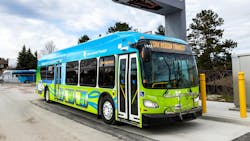CUTRIC continues steps towards cleaner transit and community in Phase II of Pan-Canadian Battery Electric Bus Demonstration and Integration Trial
Modern technology has provided the transit industry with cleaner, more efficient energy options, as agencies make the switch to hybrid, zero-emission and battery-powered transit vehicles. The Canadian Urban Transit Research & Innovation Consortium (CUTRIC) is following this new era of transit energy with the launch of Phase II of its Pan-Canadian Battery Electric Bus Demonstration and Integration Trial.
By integrating competitive bus manufacturers with competitive charging station manufacturers – all of whom are designing and delivering interoperable high-powered charging systems for electric buses – CUTRIC is working to set the standard of what electric buses and their charging systems should be.
CUTRIC is working with multiple bus and charging unit manufacturers with the goal of fostering market diversification, which will help to provide transit agencies with a wider range of solutions and mitigate risks associated with reliance on a single supplier. This approach will work to promote technological advancements and helps in the acceleration of the technology.
How it all began
Phase I of the project began in 2016, using two transit vehicle manufacturers (New Flyer Industries of Winnipeg, Manitoba, and Nova Bus of St. Eustache, Quebec) and two charging station manufacturers (ABB Group and Siemens Canada). This group worked together to successfully deploy 24 battery-electric buses (BEBs) and seven chargers across three transit agencies (Brampton Transit, TransLink and York Region Transit). The deployment of the buses and chargers began in 2019.
CUTRIC received positive feedback from Phase I of the project, which has encouraged the program's direction and development into the second phase. There was significant industry excitement, with many transit agencies expressing interest in participating in Phase II and a growing momentum towards future collaborative projects.
Jess Smith, manager of commercialization and operations at CUTRIC, owed the success of Phase I of the project to teamwork.
“CUTRIC's Pan-Canadian Electric Bus Demonstration & Integration Trial succeeded because manufacturers, who are typically competitors, collaborated closely in project meetings,” Smith said. “This collaborative effort facilitated shared solutions and accelerated the interoperability of this technology.”
Smith notes the experience CUTRIC has in project management has led to the smooth transition between projects.
“Projects like this succeed because of the project management expertise that CUTRIC provides, ensuring smooth coordination and effective implementation from conception to completion,” Smith said. “The not-for-profit nature of CUTRIC's consortium creates an environment that fosters collaboration while ensuring a vested interest from its members in the success of the projects."
Phase I is on target to reach completion by May 2024. CUTRIC’s goal moving into Phase II is to reach seamless interoperability, streamlining the adoption process of standard electric bus and bus charging models, which will help to foster competition and innovation in the electric bus market. Phase II includes comprehensive empirical analysis work on the performance of BEBs and chargers, battery degradation and assesses diesel to electric powertrain conversion efficiency.
This phase will also involve establishing a data repository for zero-emission public transit assets, enabling comparative analysis and collaboration among public fleets and transit agencies across Canada. Reports coming out of Phase II of the project will cover vehicle efficiency, battery recycling opportunities, thermal management, range barriers, cybersecurity standards, support for expanded operations, in-depot pantographs and vehicle-to-grid integration.
“By pooling expertise and resources, this approach mitigates risks, encourages innovation and addresses technical challenges more effectively,” Smith noted. “CUTRIC's membership-model plays a crucial role in facilitating collaborative projects like this by bringing together a network of stakeholders, including transit agencies, manufacturers, government entities and research institutions.”
The technology being used in the program caters to modern needs of transit agencies. The buses and overhead electric charging stations used in the program can plug into the OppCharge protocol, which is an open protocol developed by the Volvo Bus Corporation in Europe and published openly. The protocol standardizes the design of the off-board pantograph that connects the high-powered charging station to the bus, communications between the bus and the charger and performance metrics of the overall system. The learnings from that protocol supported the development of the SAE J 3105 standard which is now the standard in North America. The chargers were built to the same specifications and could be plugged into any of the transit agencies BEBs.
“While transit agencies demonstrate environmental leadership, they also improve air quality while passengers enjoy quieter, cleaner and more comfortable rides,” Smith said. “The community benefits from reduced greenhouse gas emissions, improved public health and enhanced quality of life."
A greener future in transit and the community
A broader perspective of this project is to promote a full transition to zero-emissions fleets. Greener transportation vehicles stand to benefit a wide range of stakeholders, including transit agencies, passengers and the community. CUTRIC is working to set a precedent for large greenhouse gas (GHG) producers by showcasing the feasibility and benefits of electrifying public transit, which CUTRIC says will encourage other industries to follow suit, leading to greater reductions in GHG emissions and fostering a culture of sustainability across other industry sectors.
In this program, participating agencies demonstrated GHG savings between 629 -1477 tCO2eq during 30 months. According to the U.S. Environmental Protection Agency’s GHG Equivalencies Calculator, that’s the equivalent of avoiding 150-352 gas-powered passenger cars being driven for one year.
“People that run transit across Canada are realizing now how big and expensive decarbonization is going to be,” said CUTRIC Executive Director and CEO Josipa Petrunic. “We are seeing folks from agencies across Canada showing up to get involved in this project so they can figure out how to leapfrog what might be years of pre-pandemic and pandemic-era slowdowns in decarbonization planning. We expect another successful project that shows how data analysis can lead to demonstration and commercialization success.”
What’s next
Phase II will launch with its first group participants coming together for a planned meeting in June 2024. The expected completion date for Phase II is set for the end of 2025. CUTRIC will be using data and reports from the second phase to prepare for Phase III, which is already being planned.
Phase III will launch alongside some of the work CUTRIC is doing in Phase II, focusing on new technologies in autonomy and charging. In Phase III, a new commercialization demonstration project will be in the works, with a focus on standardized and interoperable autonomous bus integration with inductive charging potential for limited applications.
CUTRIC is working to create a greener environment through the transit industry, bus by bus.
“I hope folks realize that we have only just begun the electrification journey – it’s going to be big, complicated and expensive but it’s necessary,” Petrunic said. “One more wildfire season and Canadians will be lamenting any slowdown in climate action. We need this conversion and all the hard lessons to be learned from it to go forward, to be implemented and to be built upon by 2030 to be able to prove that – as humans – we can live sustainably.”
About the Author
Eman Abu-Khaled
Associate Editor
Eman Abu-Khaled is a former associate editor with Mass Transit magazine.

